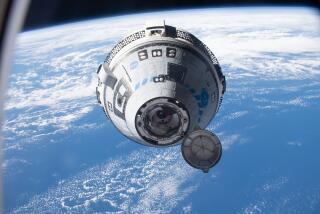Crew of Shuttle Ready for Mission That Will Seek to ‘Hot Wire’ Ailing Satellite
- Share via
KENNEDY SPACE CENTER, Fla. — The space shuttle Discovery is set to blast off here Saturday on a mission that will give the space agency a chance to do one of the things it likes to do most--show off its expertise.
In one of the shuttle program’s most daring exploits thus far, two astronauts will try to “hot wire” an $85-million satellite that has been drifting lifelessly in orbit since it failed to activate itself after it was released from the shuttle last April.
To make the repairs, astronauts James D. van Hoften and William F. Fisher will have to stop the spinning 7-ton satellite by hand, and then attach electronic panels that will enable ground controllers to activate the satellite later.
Precise Maneuvering
The satellite is so large that the astronauts will not be able to see each other as they work on opposite sides to attach the necessary handles, electronic devices and a “grappling fixture.”
Success in the operation will call for precise maneuvering, and NASA has called on one of its most experienced pilots, Air Force Col. Joe H. Engle, to command this 20th shuttle mission. Air Force Lt. Col. Richard O. Covey will be the pilot, and astronaut J. Michael Lounge will operate the robotic arm that will lift the astronauts out to the satellite.
The countdown began at 3 a.m. Thursday. Work on the rocket engines was reported behind schedule, but launch pad crews expected to make up the time well before the scheduled liftoff at 5:38 a.m. PDT Saturday. After a week in space, Discovery is to land at Edwards Air Force Base in Southern California on Sunday, Sept. 1, at 6:43 a.m. The rescue is to be attempted on either Thursday or Friday, after the crew has deployed three other satellites. One of them, a match for the one stranded in orbit, has been altered to reduce the risk of failure.
Will Set It Spinning
When the Discovery pulls alongside the lifeless Leasat 3 satellite, the astronauts will first ensure that its rockets cannot be fired while the shuttle is nearby. After they have “hot wired” the satellite, they will have to grab it and manually set it spinning at about two revolutions per minute for stability. The shuttle will then pull away, and the satellite’s fate will be in the hands of ground controllers, who will spend a number of weeks checking its systems and warming it before firing the motor that should send it from its present altitude of 242 miles toward its permanent orbit 22,300 miles above the Earth.
“It’s going to take almost two months to warm that motor up,” said Marvin Mixon, vice president of Hughes Communications Services Inc., in El Segundo, which operates the satellite. Temperatures inside the satellite dropped to an estimated minus 40 degrees as it passed through the Earth’s shadow, freezing the motor and its 8,000 pounds of solid propellant fuel. The cold poses the greatest danger to the satellite because it could have fractured the fuel tank.
“In that case, it will explode” when the motor is fired on about Oct. 29, Mixon said.
Sun to Warm Satellite
The satellite will be warmed by rotating it “like a rotisserie” to expose all of its surfaces to the sun, Mixon said.
Within 14 hours after the rescue attempt, ground controllers will learn if their diagnosis of the problem was correct, and if the operation has any chance of succeeding. At that time commands will be given to the satellite to see if it will respond. But the real test will come two months later when the command is given to fire the main engine.
Although the National Aeronautics and Space Administration is confident that it can carry out its operation successfully, Hughes engineers are less optimistic about their chances of success.
“It’s an unknown probability,” Mixon said. “But I would guess it at about 50-50.”
What is also unknown is exactly why the satellite did not start itself up after it was released by the Discovery last April 13.
“We have no data other than the fact that this thing didn’t turn on,” Mixon said.
Theory of Engineers
Engineers theorized at the time that a lever on the side of the satellite was stuck, leading to an innovative but unsuccessful attempt to snag the lever with devices made aboard the shuttle from scrap materials. Crewmen used the devices, called “flyswatters,” to yank the lever, but “that wasn’t the problem, as the whole world now knows,” Mixon said.
Ground controllers could not turn the satellite on because nothing in the system permitted them to override the satellite. They could not even communicate with the satellite because it did not deploy its antenna.
If was all very frustrating to engineers, who knew that if the satellite had still been on the ground they could have plugged test equipment into “access” panels and quickly analyzed the failure.
That led to the conclusion that if engineers couldn’t do it on the ground, maybe astronauts could do it in space. Control boxes plugged into access panels on the satellite could permit ground personnel to bypass the switches and take command.
Van Hoften and Fisher will try to attach such control boxes.
If it works, “we will break out a case of champagne and have a hell of a party,” Mixon said.
More to Read
Sign up for Essential California
The most important California stories and recommendations in your inbox every morning.
You may occasionally receive promotional content from the Los Angeles Times.













